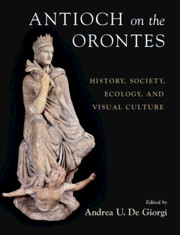Book contents
- Antioch on the Orontes
- Antioch on the Orontes
- Copyright page
- Dedication
- Contents
- Plates
- Figures
- Tables
- Contributors
- Abbreviations
- Antioch on the Orontes
- Part I Beginnings
- Part II The Making of a Capital
- Part III The People of Antioch
- Chapter 15 Women in Imperial Antioch
- Chapter 16 The Middle Classes in Fourth-Century CE Antioch
- Chapter 17 Antioch
- Chapter 18 Violence in Antioch
- Chapter 19 Antiochene Riots against Jews in Malalas’s Chronicle
- Chapter 20 Speaking of Jews
- Chapter 21 Antioch and the Political Economy of Empire in the Age of Justinian
- Part IV Religion
- Part V Crises and Resilience
- Index
- Plate Section
- References
Chapter 19 - Antiochene Riots against Jews in Malalas’s Chronicle
from Part III - The People of Antioch
Published online by Cambridge University Press: aN Invalid Date NaN
- Antioch on the Orontes
- Antioch on the Orontes
- Copyright page
- Dedication
- Contents
- Plates
- Figures
- Tables
- Contributors
- Abbreviations
- Antioch on the Orontes
- Part I Beginnings
- Part II The Making of a Capital
- Part III The People of Antioch
- Chapter 15 Women in Imperial Antioch
- Chapter 16 The Middle Classes in Fourth-Century CE Antioch
- Chapter 17 Antioch
- Chapter 18 Violence in Antioch
- Chapter 19 Antiochene Riots against Jews in Malalas’s Chronicle
- Chapter 20 Speaking of Jews
- Chapter 21 Antioch and the Political Economy of Empire in the Age of Justinian
- Part IV Religion
- Part V Crises and Resilience
- Index
- Plate Section
- References
Summary
Jews were among the founders of Antioch and contributed greatly to the social and material evolution of the city. How they adjusted to the imperial agendas of Late Antiquity, as well as their characterization in the textual record are the main objects of inquiry.
- Type
- Chapter
- Information
- Antioch on the OrontesHistory, Society, Ecology, and Visual Culture, pp. 312 - 329Publisher: Cambridge University PressPrint publication year: 2024



